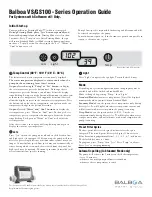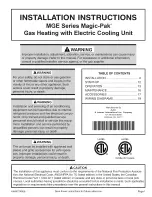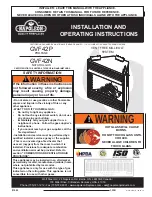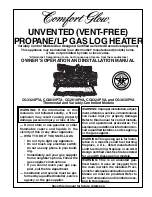
16
www.hotwater .com
100304526_2000545240 _Rev. 01
Breathing carbon monoxide can cause brain damage or death.
Always read and understand instruction manual.
• Flue gases may escape if
vent pipe is deformed,
broken, or not properly
connected.
Breathing Hazard - Carbon Monoxide Gas
WARNING
Important Notes and Warnings
•
This heater is certified to be installed using Schedule
40 PVC or CPVC or polypropylene plastic vent material.
Only use approved material. All venting material and
components must be joined with the approved primer/
cleaner and solvent cement.
•
Do not common vent this heater with any other
appliance.
•
During operation the plastic piping will expand as it
heats up and contract as it cools down. This is normal
for this type of venting. Rigidly fastening the vent piping
can cause undue stress that may result in the cracking
or fracturing the vent piping material. A fracture of the
venting pipe may pose a serious safety hazard. To
prevent stressing of the vent system, all hangers and
supports must allow the vent piping freedom to move.
•
Use long sweep elbows wherever possible. Closely
coupled elbows and short radius elbows can reduce
the venting capacity.
•
All power vented water heaters generate a certain
amount of operational noise. In order to minimize
noise transmission to the support structure, it is
recommended to use isolation pads between the pipe
hangers and the vent pipe.
•
Most power vent installations develop some
condensation in the vent piping. When using long runs
of venting or when the venting passes through cold or
unheated areas, considerable amounts of condensate
from the flue gases can develop. Provision must be
made for the condensate to drain freely from the
system or to be collected in a condensate trap(s) that
can be drained. Damage or fracture of the vent piping
may occur if the condensate is allowed to collect and
freeze. Pooling of condensate can restrict airflow and
can cause nuisance failures of the system.
INSULATION BLANKETS
Insulation blankets are available to the general public for
external use on gas water heaters but are not necessary
with these products. The purpose of an insulation blanket is
to reduce standby heat loss encountered with storage tank
heaters. Your water heater meets or exceeds the current
standards with respect to insulation and standby loss
requirements, making an insulation blanket unnecessary.
Should you choose to apply an insulation blanket to
this heater, you should follow these instructions (For
identification of components mentioned below, see
Figure 1 thru Figure 6). Failure to follow these instructions
will restrict the air flow required for proper combustion and
dilution, potentially resulting in fire, asphyxiation, serious
personal injury or death.
•
Do not apply insulation to the top of the water heater,
as this will interfere with safe operation of the blower
assembly.
•
Do not cover the outer door, thermostat or T&P relief
valve.
•
Do not cover the “Installation And Operating manual”.
Keep it on the side of the water heater or nearby for
future reference.
•
Do obtain new warning and instruction labels from the
manufacturer for placement on the blanket directly over
the existing labels.
•
Do inspect the insulation blanket frequently to make
certain it does not sag, thereby obstructing combustion
air flow.
Breathing carbon monoxide can cause brain damage or death.
Always read and understand instruction manual.
• Do not obstruct water heater air intake(s) with
insulating jacket.
• Gas and carbcn monoxide detectors are available.
• Install water heater in accordance with the
instruction manual and NFPA54.
Breathing Hazard - Carbon Monoxide Gas
WARNING
AIR REQUIREMENTS
For safe operation an adequate supply of fresh,
uncontaminated air for combustion, dilution and ventilation
must be provided.
Note:
Contaminated or dusty air may cause build-up on
the blower wheel resulting in nuisance shut downs.
















































